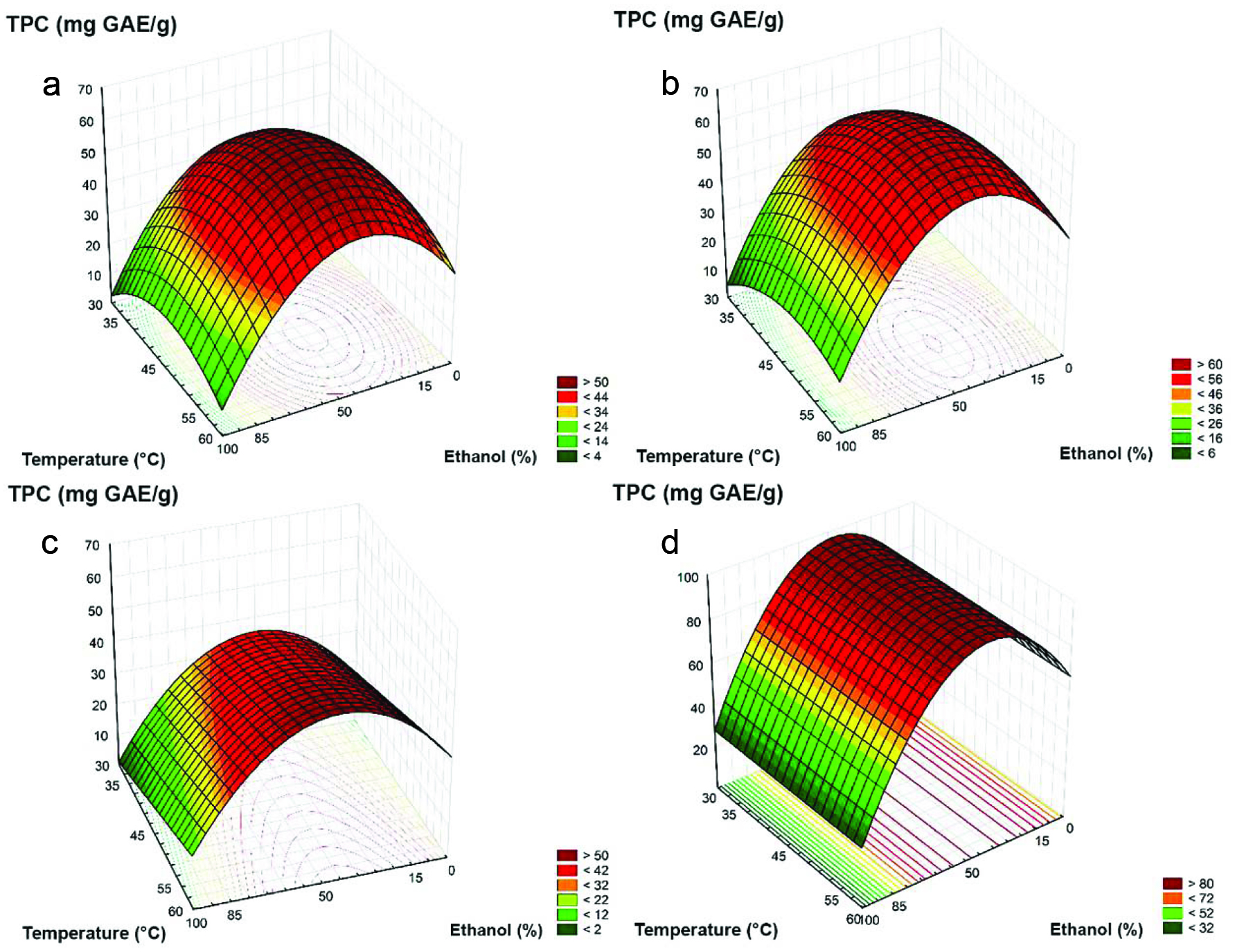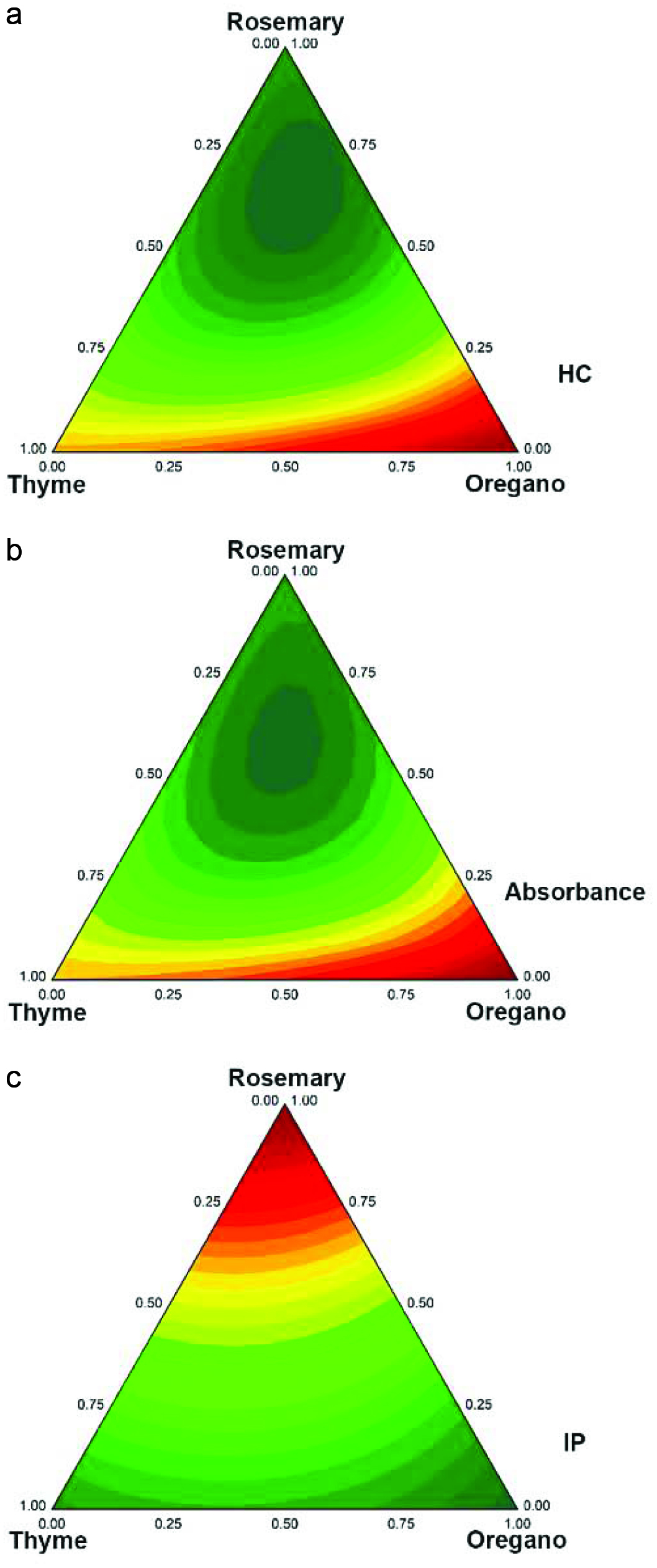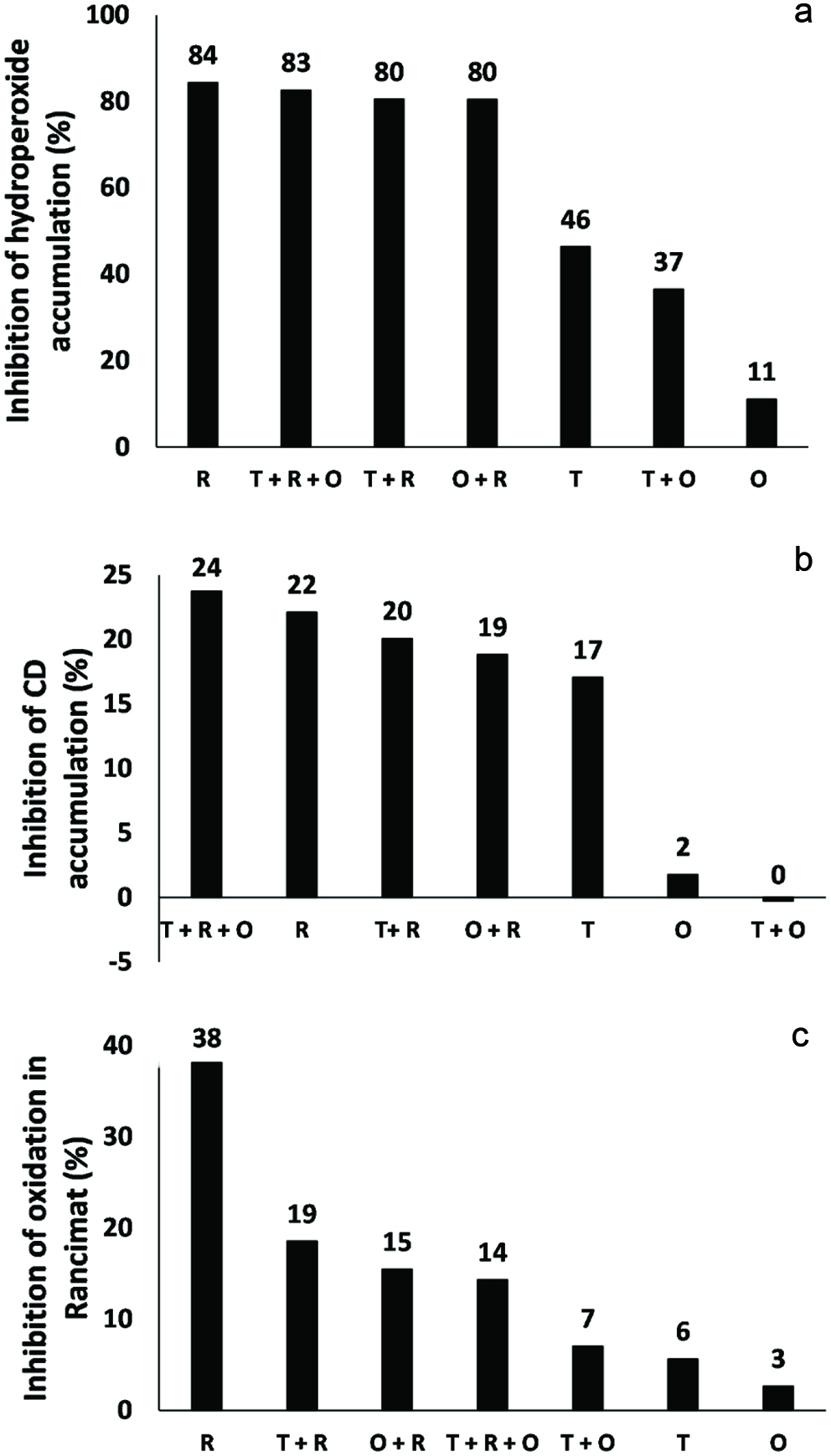
Figure 1. Effect of ethanol percentage and temperature on total phenolic content in (a) rosemary; (b) thyme; (c) sage; (d) oregano extracts. TPC, total phenolic contents; GAE, gallic acid equivalent.
| Journal of Food Bioactives, ISSN 2637-8752 print, 2637-8779 online |
| Journal website www.isnff-jfb.com |
Original Research
Volume 7, September 2019, pages 63-72
Optimization of extraction of antioxidants from aromatic herbs and their synergistic effects in a lipid model system
Figures



Tables
| Run | Independent variables | TPC (mg GAE/g)* | ||||
|---|---|---|---|---|---|---|
| % EtOH | T (°C) | Rosemary | Oregano | Sage | Thyme | |
| *Values expressed as means of triplicate determinations. GAE: gallic acid equivalents, TPC: total phenolic content. Runs 9–12, the central point (n = 4), allows to estimate the variation in the responses at the central point and provides a basis for the lack-of-fit test. | ||||||
| 1 | 15 | 35 | 43.65 | 80.58 | 28.09 | 46.53 |
| 2 | 85 | 35 | 33.77 | 64.88 | 13.83 | 33.77 |
| 3 | 15 | 55 | 42.42 | 94.28 | 33.76 | 54.95 |
| 4 | 85 | 55 | 30.83 | 62.09 | 27.09 | 35.94 |
| 5 | 0 | 45 | 40.15 | 64.36 | 27.52 | 42.27 |
| 6 | 99 | 45 | 13.31 | 21.49 | 12.69 | 20.07 |
| 7 | 50 | 30 | 36.98 | 90.73 | 35.11 | 45.50 |
| 8 | 50 | 60 | 52.25 | 93.28 | 53.91 | 64.55 |
| 9 | 50 | 45 | 43.60 | 91.65 | 46.20 | 66.59 |
| 10 | 50 | 45 | 56.18 | 92.36 | 41.66 | 59.26 |
| 11 | 50 | 45 | 57.93 | 98.82 | 46.39 | 63.32 |
| 12 | 50 | 45 | 58.92 | 94.77 | 41.80 | 67.11 |
| Source of variation (sum of squares) | Responses | |||
|---|---|---|---|---|
| Rosemary | Oregano | Sage | Thyme | |
| *If F calculated is three-fold higher than F tabulated, the model may be used for prediction purposes. | ||||
| Regression | 1,947.536 | 4,973.575 | 1,664.749 | 2,555.898 |
| Residual | 131.066 | 253.406 | 140.428 | 82.775 |
| Pure error | 3.850 | 31.397 | 20.867 | 39.291 |
| Total | 2,078.602 | 5,226.981 | 1,805.77 | 2,638.673 |
| Fcalc* | 22.289 | 88.322 | 31.612 | 53.953 |
| Ftab | 4.53 | 4.26 | 4.07 | 4.12 |
| R2 | 0.9307 | 0.9515 | 0.9222 | 0.9671 |
| Sample | Antiradical activity (μmol TE/g dry weight) | Pearson’s correlation | ||
|---|---|---|---|---|
| DPPH | ABTS | TPC × DPPH | TPC × ABTS | |
| 1Data represent the means of triplicate analysis for each sample ± standard deviations; TE is trolox equivalent. 2means with the same letters within a column are not significantly different according to Tukey’s multiple test (p > 0.05); **significant for Pearson’s correlation (p < 0.01). | ||||
| Oregano | 295.6 ± 16.4a2 | 520.8 ± 7.86a | 0.9962** | 0.9957** |
| Thyme | 181.9 ± 2.48b | 263.4 ± 3.39b | 0.9861** | 0.9683** |
| Rosemary | 178.0 ± 7.90b | 239.0 ± 2.57c | 0.9984** | 0.9955** |
| Run | Mixture2 | Relative concentration | Hydroperoxide content (mmol LOOH/L oil)3 | Absorbance at 232 nm3 | Induction Period4 | ||||||
|---|---|---|---|---|---|---|---|---|---|---|---|
| Time (days) | Time (days) | (h) | |||||||||
| 1values are expressed as means of triplicate determinations; 2Total concentration of phenolics for each run was 100 mg gallic acid equivalent/kg oil and the control was free from any herbal extracts or synthetic antioxidants. 3Results of oven test. 4Results of Rancimat test. | |||||||||||
| (x1, x2, x3) | 0 | 4 | 6 | 8 | 0 | 4 | 6 | 8 | |||
| 1 | Thyme (x1) | (1,0,0) | 0.76 | 2.44 | 6.59 | 17.5 | 5.40 | 5.52 | 6.08 | 8.26 | 8.26 |
| 2 | Oregano (x2) | (0,1,0) | 1.01 | 4.70 | 19.8 | 29.0 | 5.40 | 5.76 | 7.20 | 10.2 | 8.03 |
| 3 | Rosemary (x3) | (0,0,1) | 0.87 | 2.43 | 3.93 | 5.12 | 5.34 | 5.49 | 5.71 | 6.21 | 10.8 |
| 4 | x1 + x2 | (0.5, 0.5, 0) | 0.55 | 2.70 | 14.2 | 20.7 | 5.37 | 5.64 | 7.35 | 8.77 | 8.37 |
| 5 | x1 + x3 | (0.5, 0, 0.5) | 0.37 | 2.92 | 4.92 | 6.37 | 5.40 | 5.69 | 5.86 | 6.48 | 9.27 |
| 6 | x2 + x3 | (0, 0.5, 0.5) | 0.92 | 2.97 | 5.06 | 6.38 | 5.41 | 6.15 | 5.95 | 6.61 | 9.03 |
| 7 | x1 + x2 + x3 | (0.33, 0.33, 0.33) | 0.40 | 2.88 | 4.56 | 5.69 | 5.21 | 5.51 | 5.59 | 6.07 | 8.94 |
| 8 | Control | (0,0,0) | 0.45 | 2.41 | 21.1 | 32.6 | 5.42 | 5.78 | 7.33 | 10.8 | 7.82 |
| Source of variation (sum of squares) | Responses | ||
|---|---|---|---|
| Hydroperoxide content | Absorbance (232 nm) | Rancimat test | |
| *If F calculated is three-fold higher than F tabulated, the model may be used for prediction purposes. | |||
| Regression | 1,617.548 | 45.59242 | 9.98347 |
| Residual | 144.284 | 4.40783 | 0.07705 |
| Total | 1,761.32 | 50.00025 | 10.06052 |
| Fcalc | 26.15872 | 24.13484 | 151.1666 |
| Ftab | 2.85 | 2.85 | 3.87 |
| R2 | 0.9181 | 0.9118 | 0.9923 |
| Hydroperoxide content = 17.48 × Thyme + 29.02 × Oregano + 5.12 × Rosemary − 10.30 × Thyme × Oregano − 19.70 × Thyme × Rosemary − 42.76 × Oregano × Rosemary − 92.54 × Thyme × Oregano × Rosemary |
| Absorbance at 232 nm = 8.26 × Thyme + 10.23 × Oregano + 6.20 × Rosemary − 1.89 × Thyme × Oregano − 3.01 × Oregano × Rosemary − 6.45 × Oregano × Rosemary − 24.16 × Thyme × Oregano × Rosemary |
| Induction Period = 8.26 × Thyme + 8.03 × Oregano + 10.75 × Rosemary + 0.89 × Thyme × Orenago − 0.94 × Thyme × Rosemary − 1.44 × Oregano × Rosemary + 2.46 × Thyme × Oregano × Rosemary |